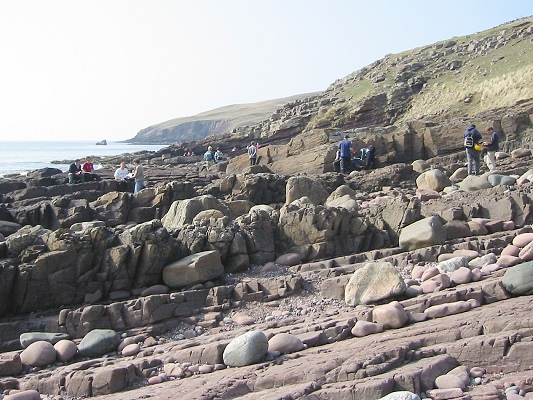
| Home | Geological History | Stratigraphy | Area map | Rock Index | About |
| Scourie | Achmelvich | Laxford | Clachtoll | Stoer | Assynt | Skiag Bridge | Glencoul | Knockan | Borralan | Ledmore |

![]() Red siltstones and sandstones on the shore of the Bay of
Stoer. In the distance, a little offshore, the rock shaped
like a shark's fin is part of the outcrop of the volcanic
mudflow of Stac Fada (see below).
Red siltstones and sandstones on the shore of the Bay of
Stoer. In the distance, a little offshore, the rock shaped
like a shark's fin is part of the outcrop of the volcanic
mudflow of Stac Fada (see below).
On the coast at Stoer bay, a succession of red rocks, dominated by sandstones and siltstones, preserves a record of the Precambrian environment in their textures and structures. They suggest a semi-arid climate where migrating river systems brought in coarse and fine sediment, where lakes formed and dried out, the sediment surface sometimes covered with blooms of single-celled life, at other times shrinking and cracking in the sun.
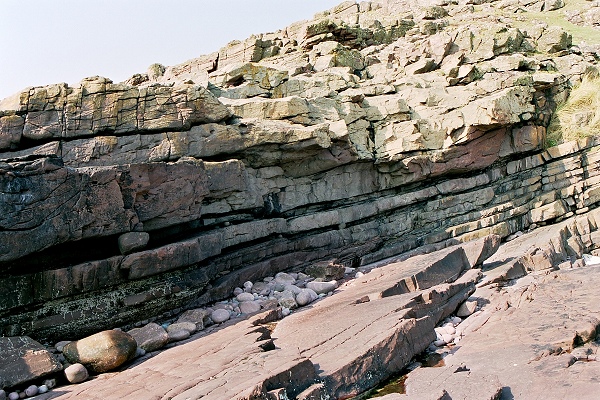
![]() These sandstone layers increase in bed thickness and also
in grain size upwards. The base of each bed commonly cuts
down slightly into the bed below, forming a shallow
channel. These upper layers are river deposits - with time,
deeper channels and more vigorous streams brought in larger
amounts of coarser sand. The bedding surfaces at the bottom
of the photo have ripple-marks on them, like lake-shore
sand-flats.
These sandstone layers increase in bed thickness and also
in grain size upwards. The base of each bed commonly cuts
down slightly into the bed below, forming a shallow
channel. These upper layers are river deposits - with time,
deeper channels and more vigorous streams brought in larger
amounts of coarser sand. The bedding surfaces at the bottom
of the photo have ripple-marks on them, like lake-shore
sand-flats.
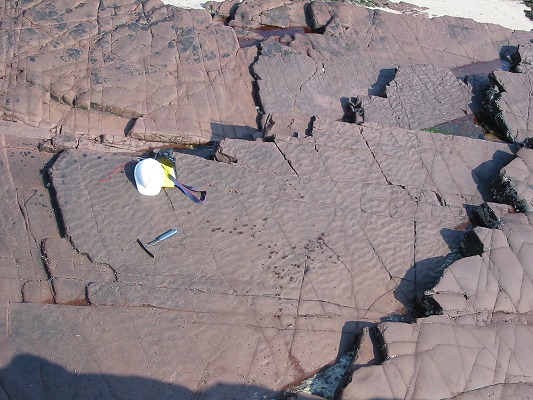
![]() View from above of the ripple-marked surfaces on top of
beds of fine sandstone. Measuring the alignment of these
ripples tells us about ancient current directions.
View from above of the ripple-marked surfaces on top of
beds of fine sandstone. Measuring the alignment of these
ripples tells us about ancient current directions.
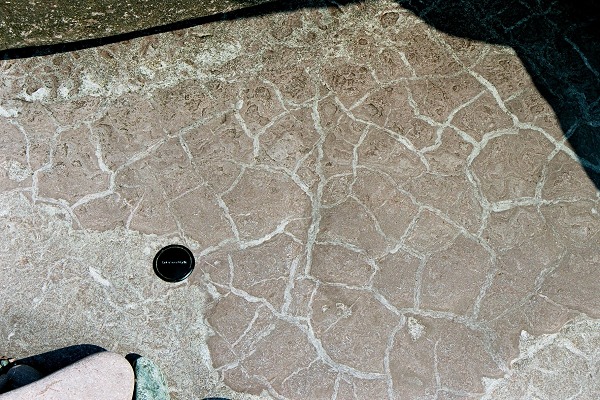
![]() This pattern of polygonal cracks was formed in a muddy
siltstone, probably a lake deposit, as it dried out. The
cracks became filled with light-coloured sand from the next
thin layer of sediment, and now they stand out in bold
contrast.
This pattern of polygonal cracks was formed in a muddy
siltstone, probably a lake deposit, as it dried out. The
cracks became filled with light-coloured sand from the next
thin layer of sediment, and now they stand out in bold
contrast.
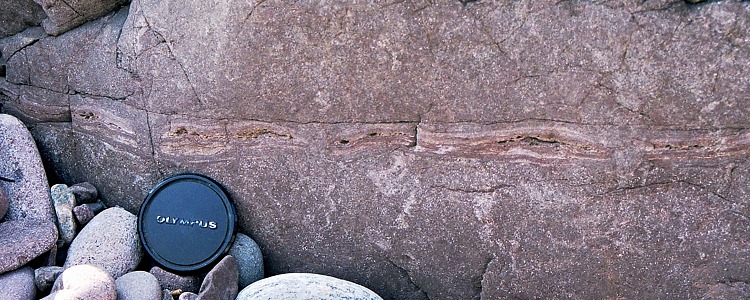
![]() This set of fragmented thin layers in purple sandstone has
the pitted weathering usually developed by carbonate-rich
material. Laminated structures like this are believed to
form when microbes (commonly called blue-green algae, but
more strictly cyanobacteria) formed a thin mat that bound
the sediment surface together. Cyanobacteria were one of
the characteristic simple life forms of the Precambrian
era.
This set of fragmented thin layers in purple sandstone has
the pitted weathering usually developed by carbonate-rich
material. Laminated structures like this are believed to
form when microbes (commonly called blue-green algae, but
more strictly cyanobacteria) formed a thin mat that bound
the sediment surface together. Cyanobacteria were one of
the characteristic simple life forms of the Precambrian
era.
|
Meteorite impact deposit, Torridonian (Stoer Group) Stoer |
| Scourie | Achmelvich | Laxford | Clachtoll | Stoer | Assynt | Skiag Bridge | Glencoul | Knockan | Borralan | Ledmore |
| Home | Geological History | Stratigraphy | Area map | Rock Index | About |
D.J. Waters, Department of Earth Sciences, June 2008